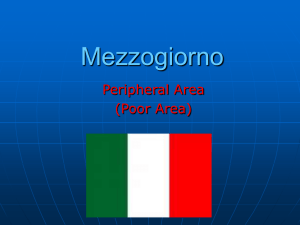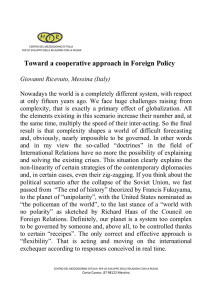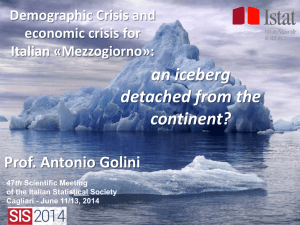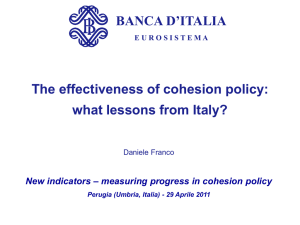Paper 1 - ox.ac.uk
advertisement
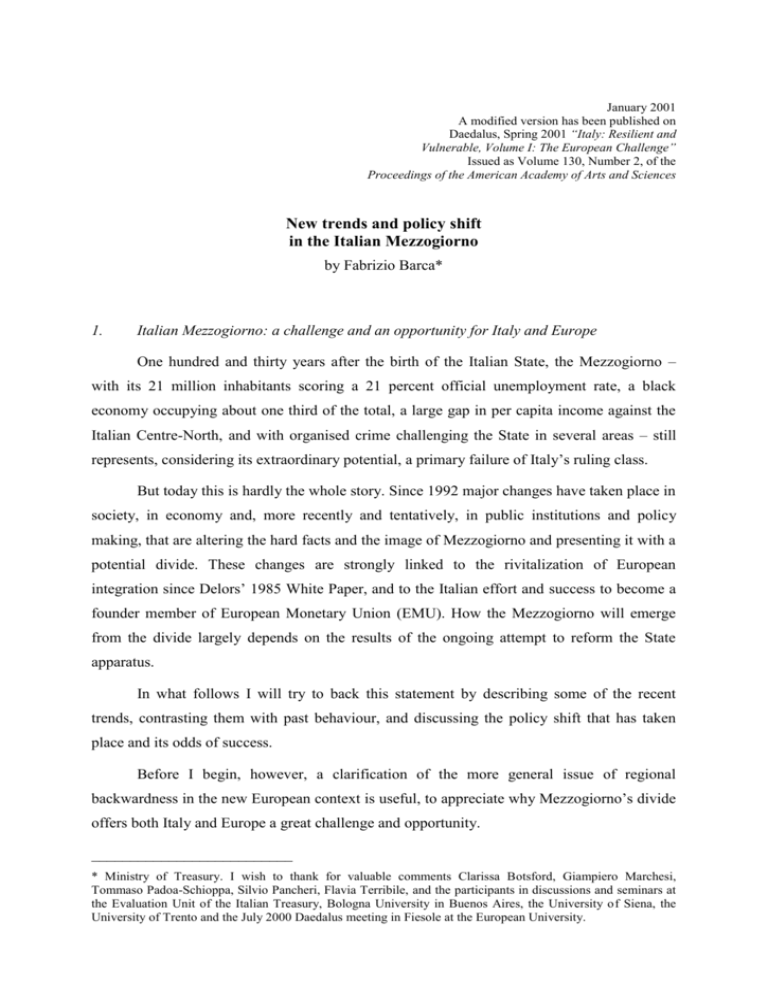
January 2001 A modified version has been published on Daedalus, Spring 2001 “Italy: Resilient and Vulnerable, Volume I: The European Challenge” Issued as Volume 130, Number 2, of the Proceedings of the American Academy of Arts and Sciences New trends and policy shift in the Italian Mezzogiorno by Fabrizio Barca* 1. Italian Mezzogiorno: a challenge and an opportunity for Italy and Europe One hundred and thirty years after the birth of the Italian State, the Mezzogiorno – with its 21 million inhabitants scoring a 21 percent official unemployment rate, a black economy occupying about one third of the total, a large gap in per capita income against the Italian Centre-North, and with organised crime challenging the State in several areas – still represents, considering its extraordinary potential, a primary failure of Italy’s ruling class. But today this is hardly the whole story. Since 1992 major changes have taken place in society, in economy and, more recently and tentatively, in public institutions and policy making, that are altering the hard facts and the image of Mezzogiorno and presenting it with a potential divide. These changes are strongly linked to the rivitalization of European integration since Delors’ 1985 White Paper, and to the Italian effort and success to become a founder member of European Monetary Union (EMU). How the Mezzogiorno will emerge from the divide largely depends on the results of the ongoing attempt to reform the State apparatus. In what follows I will try to back this statement by describing some of the recent trends, contrasting them with past behaviour, and discussing the policy shift that has taken place and its odds of success. Before I begin, however, a clarification of the more general issue of regional backwardness in the new European context is useful, to appreciate why Mezzogiorno’s divide offers both Italy and Europe a great challenge and opportunity. __________________________ * Ministry of Treasury. I wish to thank for valuable comments Clarissa Botsford, Giampiero Marchesi, Tommaso Padoa-Schioppa, Silvio Pancheri, Flavia Terribile, and the participants in discussions and seminars at the Evaluation Unit of the Italian Treasury, Bologna University in Buenos Aires, the University of Siena, the University of Trento and the July 2000 Daedalus meeting in Fiesole at the European University. In terms of per capita income, the gap between the Mezzogiorno and the fast-growing Centre-North fell until the mid sixties; it then stabilised for twenty years to rise again till half nineties (see fig. 1). It is now measured at about 44 percent, though this figure, while including an estimate of the black economy, does not take into account the higher purchasing power of a lira unit in the South. Considering the whole of Europe, recent studies1 show that in the second half of the century, while productivity and income gaps among States have diminished, gaps among regions, after a reduction, have either remained unchanged or increased. More than 80 million Europeans, about one quarter of the EU population, live in regions with a per capita income below 75 per cent of the EU average; the figure will increase with EU enlargement to 12 EastEuropean states. Only 2 per cent of the US population is in a similar bracket (Puga (1998)). The Mezzogiorno represents, therefore, an extreme version of a more general European condition. Income gap: 1951-1998 (1) Fig. 1 46 45 44 43 42 41 40 39 (1) Differential between per capita income of Mezzogiorno and Centre North as a share of per capita income of Centre North (current prices). Source: Casavola, Sestito (2000) based on Svimez data for the years 1951-1995 (with a break in 1970) and Istat data, Territorial Accounts Sec95, for the years 1995-1998. 1 See Quah (1996), Puga (1998). 2 The persistence of regional gaps is strongly influenced by the inadequate pace of European cultural and social integration. Two further obstacles have also been at work for a long time: national policies aimed at protecting the uncompetitive industries of specific territories; and barriers to capital mobility, including the strategic use of the exchange rate. The first obstacle was gradually dismantled from 1985 onwards. The second was removed in 1998; it made the implementation of new policies a “win-or-lose-Europe” issue. The reason for such a strong statement is straightforward. Faced with full capital mobility and the impossibility to enact compensatory mercantilistic policies at national level, backward regions in Europe – from Cornwall in the United Kingdom to Epirus in Greece, Galicia in Spain to Brandenburg in Germany, Calabria in Italy to parts of Central Norrland in Sweden – have come up against a difficult choice. They can enact policies aimed at increasing their territorial competitiveness by matching the positive externalities of advanced regions and offering capital “credible prophecies”2 of higher profits; by doing so they can cash in the benefits of the new capital mobility and turn the adventurous leap forward of Monetary Union into a major asset. Alternatively, they can fail to create such prophecies. One way to fail is to take a laisser faire attitude which ignores the very strong path dependence of territorial development and the fact that, once freed from any constraint, capital tends to move into existing productive agglomerations and by doing so to further increase their superior profitability. Another way is to continue the ex-post compensating, subsidising regional policies of the last decades which weakened entrepreneurial animal spirit. In both cases, capital mobility is bound to punish backward regions much more than in the past. The fragile path of European unification would be severely hampered by this widening of regional gaps; even more so after enlargement. The implementation in the Mezzogiorno of a new development policy aimed at increasing territorial competitiveness thus represents an important test case for the whole of Europe. At the same time, Europe provides Mezzogiorno with an indispensable framework for credibly carrying out such a policy. Increasing territorial competitiveness requires highly qualified public investments with as much private financial support as possible; this in turn requires a drastic modernization and streamlining of public administration and the introduction of binding incentive devices on public officials. The European commitment can lend Mezzogiorno the credibility to perform a similar feat. 2 See Krugman (1991). 3 If this task were actually to be accomplished Italy as a whole would benefit, non only via the growth push from its southern areas. Modernisation of public administration and new methods for selecting the ruling class are not just Mezzogiorno’s problems; they limit the economic and strategic potential of the whole country. As Padoa-Schioppa argues in this same issue, the urgency of a well functioning State has been increased by the progress of European Union. Mezzogiorno, under the pressure of necessity, could provide Italy with a much needed push to accomplish its long transition process to mature statehood. 2. Economic and social turnarounds Profound changes are taking place in the Mezzogiorno’s economy and society which have created new opportunities for its development. These changes have followed three concurring events: the end of a 40-year top-down economic policy; a strong tightening of law enforcement; the beginning of a radical devolution of political and administrative power. All these events took places in 1992-‘93. In 1950 the task of ensuring that development in the Mezzogiorno kept up with the quick pace of the rest of the country had been addressed by setting up a “temporary” national public Agency – the Cassa per il Mezzogiorno – which was put in the hands of public servants with an international reputation and to skilled and well paid technicians3. This choice was part of a general strategy which held that ordinary public administrations, because of their rigidities, their links with the fascist regime and their inability to pay adequate wages, couldn’t be trusted to carry out complex public investments policies. The creation and development of state-owned corporations such as ENI, IRI or Mediobanca were part of the same strategy4. Over the following 15 years, the Cassa set in place major infrastructure and incentives to industrial sectors. The results were very significant and contributed to the very high growth rates of this period. But there were costs: the Rome-centred, highly discretionary approach left little room for making local authorities responsible and public choices accountable. These turned out to be very serious features, especially in a society where neither local nor central governments were trusted, as Banfield controversial view of the See D’Antone (1997). See Barca, Trento (1997) e Barca (1997) where the economic and political rationale for such strategy described as an "extraordinary compromise"- is discussed. 3 4 4 Mezzogiorno’s disease had pointed out5. Members of the local ruling class, mostly playing as mediators with Rome decision-makers, were delegitimated as providers of public goods. By the mid-sixties, the failures of the system began to show. The lack of accountability and of an incentive-compatible governance system caused major mistakes in resource allocation and paved the way for the capture of public authorities by private interests6. Moreover, both the Cassa and the state-owned enterprises were charged with further goals – increasing the pace of investments, creating new employment – that went well beyond those of a temporary catch-up. The negative economic effects were immediate: the income gap stopped dropping, while the increasingly ex-post-compensatory nature of the transfers to Mezzogiorno began to show in a much lower propensity to save7. Nor did the enactment in 1975 of a Constitutional proviso to create regional governments changed the picture. Its ineffectiveness owed more to the persistence of a topdown Rome-centred approach to public investment run by the ever present Cassa, making the eight Southern Regions into dispensable and non-credible actors, than it did to a supposedly natural “lack of civicness”, as argued by Putnam (1993). Countries or Regions’ performance hardly depends on different degrees of “exogenous civicness” - Bagnasco (1999) rightly argues - but rather on the degree to which institutions are created through the political process so as to make use of whatever kind of civicness exists. Now, in our case, the existing institutional frameworks gave regional and municipal governments little choice but to “beg” for more resources in the appropriate Rome offices. The true8 dismantling of the Cassa was delayed by the network of private interests that it had created. It finally took place in 1992 when the pressure of European integration made it impossible for Italy to persist in implementing clearly anti competitive policies and to freely finance the subsidies of the Cassa or the income losses of IRI. One year after, the process of privatising state-owned enterprises was launched, bringing “compensatory investments” in the South9 quickly to a halt. See Banfield (1958); for the debate that followed Banfield’s “amoral familism” thesis see De Masi (1976). See Trigilia (1992) e Barca-Trento (1997). 7 See Bollino, Magnani (1997). 8 In 1986 the Cassa was closed and another Agency, called “Agenzia del Mezzogiorno”, was created in its place. While being formally entrusted with more power, the Southern Regions were not put in the condition to exert it: the Agenzia and special units created inside the main central administrations carried on the old jobs, possibly with less accountability than before. 9 See Barca-Trento (1997). 5 6 5 At the same time, the long-repressed uneasiness of the middle classes in the Centre and North about State intervention in the South came to the surface with the rise of the Northern League and led to the opportunistic cancellation of the Mezzogiorno issue from the political agendas of all parties. Since no alternative economic policy was then implemented, public investments in the Mezzogiorno started dropping even more than in the economy as a whole: from a top level of 21 billion Euro in 1992 (at 1994 prices), to a minimum level of 15 billion Euro. Only in one policy area was the central government more active than in the past: law enforcement. After the failed attempts of the early eighties, when General Carlo Alberto Dalla Chiesa – who had achieved major success in the fight against the Red Brigade terrorists – failed to get adequate support from Christian Democrat–led governments in dealing with the Sicilian Mafia, the creation of a strong anti-mafia pool of magistrates and the 1987 “maxitrial” as it became known, dealt a hefty blow to Mezzogiorno’s organised crime. In the meantime the reduction of State subsidies to the area shrank the opportunities for organised crime to act as fund allocator. In a changing social context where anti-mafia associations started developing and acting in the open and with popular support, links between organised crime and politicians were put under strain: in March 1992 Sicilian Christian Democrat leader Salvo Lima, identified by the Italian Parliament’s anti-mafia commission as a key figure in the organised crime structure, was gunned down in Palermo. Few months later, in an extreme show of its strength, the Mafia also assassinated two of the most prominent members of the anti-mafia pool: Giovanni Falcone and Paolo Borsellino. The extension of measures in favour of collaborators (“pentiti”), from family protections to reduction in sentences, however, allowed the State to deal even stronger blows to organised crime. In 1993 Mafia boss Salvatore Riina was arrested. In the same year Leoluca Orlando, who had severed his links with Giulio Andreotti’s Party, won the post of Palermo’s major with a radically new political agenda. Between 1991 and 1993 about 25 municipal governments were dissolved each year because of their ties with organised crime. The number of incriminations in the four regions where organised crime is active (Campania, Calabria, Apulia and Sicily: with respectively the Camorra, Ndrangheta, Sacra Corona Unita and Mafia) as a share of total incriminations increased between the late eighties and 1993 from less than 25 to more than 35 percent. 6 At the same time, in 1993, a third crucial event took place which offered a chance to new local leaders to emerge. A reform in the electoral system of municipal governments was introduced, by which city mayors would be directly voted in. Since then the strengthening and increased personal responsibility of mayors has often created the incentive and the means for them to modernise their administration, to restore the historical centres of as diverse towns as Salerno and Bari, Catania and Cosenza, Naples and Syracuse, and to plan much needed infrastructures in rural and urban areas. To sum up: at the beginning of the nineties, three distinct and partly independent changes took place in the policy for Mezzogiorno. Transfers to the area were reduced; law enforcement was increased; the responsibilities of local authorities were enhanced. It is early to analyse how much of what followed can be attributed to these changes and their interaction. But there is no doubt that, with some time delay, in many areas of the Mezzogiorno – though not in all – local actors, both private and public, made themselves more effective and achieved noticeable results.10 After 1995 the turnover rate – birth rate net of death rate – of southern non-agricultural enterprises started rising; by 1997 it had become much higher than in the Centre-North (see fig. 2). This very lively entrepreneurial climate led to the strengthening of many local agglomerations of firms. Even with reference to the first half of the nineties, when employment fell in the whole of the South by more than 6 percent, employment increased in 102 out of the 365 local labour systems11 into which the area can be divided. In some territories private and public actors came together to create new partnerships called “territorial pacts”, presenting central government with common projects for financing12. The perception was brought to the national policy forum that several agglomerations of firms with economic prospects had indeed been around for a long time in the Mezzogiorno13. 10 Many of the economic and social changes described here were first detected by Bodo-Viesti (1997) in a volume called “The great turnaround” and by essays published by the journal “Meridiana” (see, among others, Cersosimo-Donzelli (1996) and Bevilacqua (1998)). See also Viesti (1999) and DPS (1999). 11 Local labour systems are defined as territories where there is a high coincidence between place of residence and place of work: see Istat (1997). 12 In some cases, these partnerships turned out to be yet another version of the old habit of local actors coming together with dubious projects just to submit pleas for money to “Rome”; in many other cases, though, projects were knowledge intensive and envisaged true and innovative co-operation among local actors. See Cersosimo (2000) and DPS (2000). 13 See Brusco, Paba (1997). 7 Stock of non-agricultural enterprises (number of registered firms; 1993= 100) Fig. 2 Mezzogiorno Centre North 115 115 110 110 105 105 100 100 95 95 1993 1994 1995 1996 1997 1998 1999 2000 1993 1994 1995 1996 1997 1998 1999 2000 Source : Unioncamere At the same time, the attitude towards risky jobs and mobility clearly changed. According to surveys, young Southerners are now much readier than their Northern counterparts to start self-employed activities. Istat surveys show that they are readier to find dependent jobs in provinces other than their own. Merchandise exports Fig. 3 (percentage changes at current prices) 35,0 30,0 Mezzogiorno 25,0 Centre North 20,0 15,0 10,0 5,0 0,0 -5,0 1993 1994 1995 1996 1997 1998 1999 2000* Source: Istat * January-September 8 An increase in the competitiveness of the Mezzogiorno’s enterprises also took place, as shown by the strong and continuous rise since 1993-94 both in exports and in the inward flows of tourists (see figg. 3 and 4), though they are both still very low by Italian and European standards14. Foreign tourism Fig. 4 (thousands of persons per day; 1993=100) Mezzogiorno 180 Centre North 180 160 160 140 140 120 120 100 100 80 80 1993 1994 1995 1996 1997 1998 1999 1993 1994 1995 1996 1997 1998 1999 Source : Istat These changes provide four clear messages. First of all, in spite of path dependency, changes can take place even in the Italian Mezzogiorno. With its age-old traditions and idiosyncratic culture and with its peculiar heritage of social relations that goes potentially beyond enlarged family networks to reach out towards international links (hospitality, esterophilia, curiosity and open-mindedness), the Mezzogiorno can get out of its stalemate if this heritage is exploited to the full by an appropriate institutional design, as the reform of the municipal electoral system or the tightening of law enforcement suggest. Second, the shift has taken place at the very time when the “temporary” top-down Roman-centred policy was interrupted: higher local responsibility looks like the driving force for change. 14 Exports represent about 9 percent of GDP as opposed to 20 percent in Italy as a whole. 9 Third, market-driven and local policy-driven turnarounds revolve around a better economic exploitation of the resources peculiar to many areas of the Mezzogiorno and largely under-utilised: Apennine mountain and coast environments; cultural heritage; skilled human capital, both intellectual and manual. Fourth and finally, the economic and social turnaround is not yet fast and strong enough to reverse long engraved prejudices and to redirect towards the area national and international capitals. Changes effect only few areas and sectors and are sometimes of a small order of magnitude. Most of all, the State ha until recently been slow to adjust: increasing municipal efficiency has not been matched by Regions’ and central State’s ability to increase the efficiency of its apparatus and to plan and implement those public investments that are called in by market awakening. These lessons call for a policy that is radically different not only from past Italian policy but also from traditional EU regional intervention. 3. Ideas for a new policy European regional policy has for a long time largely aimed to compensate backward regions ex-post for their lower incomes and attractiveness. In spite of a recent important shift in general principles15 and several alternative experiences16, the European debate still centres largely on interventions backing specific sectors – industry, agriculture, communication, training – and on incentives aimed at compensating firms for the lower returns of backward regions and creating new agglomerations.17 All this is very unfortunate. The logic of sectoral incentives runs contrary to the reduction in competitive barriers, is bound to lead backward regions into a zero-sum rent-shifting war, and assumes a centralised knowledge about opportunities in the various territories that is simply not available. The current trend in the Mezzogiorno calls for a radically different approach that faces up to the challenge of high capital mobility by enhancing territories’ present and potential opportunities and attractions so as to create a permanent incentive for local entrepreneurs to set up and enlarge their businesses and for external ones to come to the area18. 15 See European Commission (1999). See for example on the Ireland case, OECD (1996). 17 See Puga (1998). 18 See Barca (1998). 16 10 A policy aimed at increasing territorial competitiveness must be centred on the potential competitive heritage of the area: Mezzogiorno’s human capital; existing agglomerations of firms; cultural and natural resources. All these assets are simply not used to their potential. Underutilization of human capital is extremely visible. More than one quarter of all labour time is performed outside any legal framework: while significant shares of it are represented by illegal activities and very low productivity jobs, the majority of that “black labour” is performed by skilled workers whose productivity potential is rather high. Furthermore, these is a reservoir of unemployed youth with significant university training and with reservation wages lower than those of other European countries, an asset already exploited by some highly technological multinational corporations in university areas such as Bari and Catania (Bosch, Getrag, ST Microelectronics, etc.). The potential comparative advantage in terms of firms’ agglomerations has been largely underestimated in the past. As recent studies of similar clusters of successful firms in the South and in the Italian North-East show19, agglomerations in the Mezzogiorno boast an export-propensity and labour quality no different from those in the rest of the country. Where they fail is in their propensity to build a strong network of formal and informal relations within the clusters: it is precisely on these relations that agglomerations’ positive externalities and productivity gains depend20. Firms in the Mezzogiorno’s clusters buy less from each other than in the Centre-North, and prefer to deal with firms outside the cluster, while subcontractors have less diversification of clients21; firms also fail to cooperate in setting up common high-quality services, in creating risk-sharing institutions that allow for lower credit costs, in lobbying together for specific improvements in their business environment. The reason for this differing behaviour largely lies – as interviews show22 - in the lack of trust relations inside the clusters. All this suggests that, rather than trying to create new agglomerations or pinpointing preferential areas for development or incentives, policy should aim at enhancing formal and informal relations inside existing agglomerations. This would increase the returns on investments in those agglomerations and would set into motion a virtuous circle of inward investments. 19 See Mazzola, Asmundo (1999) and Omiccioli (2000). See Signorini in this same issue. 21 See Mazzola, Asmundo (1999) and Omiccioli (2000). 22 See again Mazzola, Asmundo (1999). 20 11 Similarly under-exploited are natural and cultural resources. Protected natural areas represent seven percent of the South, the same share as in the North. They include vast and uncontaminated territories, home to many rare plant and animal species – such as the Loricato Pine and the Royal Eagle in the Pollino National Park, or the Pellegrine Falcon and the Royal Owl in Aspromonte – as well as archaeological sites dating back to Greek colonization, and cultivated slopes on the fertile vulcanic land of Etna. In spite of this variety, the number of visitors per hectare of land is one third that in the Centre-North. More tragically, while in the Mezzogiorno water is a plentiful resource and many reservoirs have been built, one household out of five does not receive water on a regular basis: many of the reservoirs have never been linked to the main water supply. The beds of many seasonal rivers have not been dredged and their banks left unfortified for years, posing a dramatic danger to people’s lives. As for the cultural heritage, there are hundred of sites of extraordinary historical and aesthetic value, well beyond the reknowned areas of Pompei, Selinunte or Villa Armerina. They include among many others: the vast network of Magna Grecia strongholds; the Apulian-Lucan cliff-dwellings on the border between of Basilicata and Apulia; the great architectural achievements of the Bourbon reign; the Neapolitan museums; the network of Norman castles in Apulia; and countless others. In particular, archaeological sites cover 1,400 hectares, against 1,000 in the Centre-North. But only 38 percent of these areas are open to the public, often only very partially. 31 insulae are today accessible in Pompei, as against the 110 existing ones. When there are museums – only 4.4 per 100,000 inhabitants, as against 9.6 in the Centre-North – they are often extraordinary, but only 7 percent of them offer some service to visitors, as opposed to 70 per cent in the Centre-North. All this natural and cultural potential make the Mezzogiorno even more attractive than the Centre-North, despite Rome, Florence, Venice and “Chiantishire”: on a composite index of tourist attraction, Mezzogiorno scores 36 against 32 for the whole of the Centre-North. But natural and cultural sites are often locked, inaccessible or insufficiently manned; marketing is inadequate and no proper strategy is implemented; opportunities to develop manufacturing traditional crafts as well as sophisticated software products offering virtual reconstruction of sites - and agro-industrial productions linked to those sites are rarely exploited. There are 62 tourists per 100 inhabitants in the South against 163 in the Centre-North. Four policy priorities emerge from this picture. 12 Increasing competition. Not only does the Mezzogiorno need to take the plunge of higher capital mobility with the outside, as the way to allow for an acceleration of growth, but it also requires stronger competition in both labour and goods markets. This means: lower entry and exit costs from jobs; much greater role of firms bargaining in wage setting; elimination of administrative and market barriers in the market for business services. Strengthening communication. Much of the Mezzogiorno is still very distant from major European and international centres. A fast-growing demand for sea and air transport from Southern Regions requires relevant investments in both harbours and airports. The main railway route allows passenger trains south of Naples to run at no more than 80 km per hour. The fastest developing European transhipment harbour, Gioia Tauro, risks wasting the chance to spur on neighbouring areas because of the lack of proper railway connections to Northern Regions. The challenge here is to escape from an archaic approach whereby major communications infrastructures in the Mezzogiorno are seen as great source of employment in the construction period. Evaluation of alternative options should instead be performed, implementing well-established international standards. Fostering agglomerations. The third priority calls for policies aimed at increasing “relational capital”. These include: an even stronger hold on law enforcement and a modernisation of the judiciary system so as to favour the development of contractual relations inside the agglomerations; a radical modernisation of local administrations, with the introduction of accountable procedures for the selection of local projects; institution building, whereby private and public local actors are encouraged to come together and to create partnerships; adequate urban plans; incentives for networking, making full use of new information technologies, offering high-quality small firms already operating in the South the opportunity to market the “diversity” of their products with distant consumers; training of local manpower. Making natural and cultural resources accessible. To achieve this final priority public investments must be realised to restore archaeological sites, fortresses and monuments, to establish attractive museums, to prevent coastal erosion, to protect natural areas, but also to improve transport communication to these sites, to set aside areas and provide light infrastructure so as to allow the development of appropriate hospitality services for all types of tourism, to complement archaeological sites with virtual screen reconstructions. Policy also 13 requires the privatisation of water utilities and the investments necessary to increase their effectiveness and efficiency. In order to increase territorial competitiveness through these four policy priorities, improvement of the services provided by the State, particularly at local level, must be achieved. The public investments - whether publicly or privately financed - necessary to achieve these goals must be highly qualified; this in turn requires a profound reform of the way they are selected. In short, a radical improvement in the efficiency of the State apparatus comes to the fore as the primary factor not to loose Mezzogiorno’s momentum. The opportunity to move in this direction arrived at the beginning of 1998. 4. The 2000-2006 experiment In Spring 1998, the Italian Treasury was charged with the task of devising a plan for the year 2000-2006 for the use of about 24 billion Euro of European funds – 48 billion, once national co-financing is included – for public investments in the Italian Mezzogiorno. Drawing up the Plan took 18 months of intense and at times harsh technical and political negotiation between central State, Regions, municipalities and social partners. The Plan was approved by the EU in July 2000. The strong visibility and accountability of EU funds, the chance to make their use conditional on the implementation of a new and binding set of rules, the credibility that these rules can derive from being written into a European international agreement: these were all reasons why the 2000-2006 plan lends itself to becoming a turnaround in the economic policy for the Mezzogiorno. The Plan addresses three of the four priorities. The first, increasing competition, lies outside its reach, but its implementation is indispensable to achieve the other targets. In particular, decentralisation of wage bargaining and more flexible exit and entry rules should now be accepted by Unions as complementary to the 2000-2006 experiment. As for the “communication” priority (19 percent of total resources), the Plan lay the foundations for urgent choices to be made. Twenty-five years after engineering studies were started, a study to evaluate the economic impact of two alternative solutions to the 14 establishment of a proper communication link between Sicily and Calabria – a 3,690 meters long Bridge or the setting of several competitive sea linkages across the Strait – has been accomplished by an advisor selected through public tender: the ground for a clear-cut choices has been laid. Similar studies are being carried out for the rest of the area. This new procedure should also allow significant private funds to be attracted. Except for the judiciary sector, where existing EU regulation prevents structural funds from being spent, all means to “foster agglomerations’” receive special attention. A hefty 32 percent of the total Plan’s resources is assigned to local development. Against strong pressure from the conservative Italian Confederation of Industrialists, resources for incentives have been drastically reduced compared to the past, so as to avoid a depletion of resources available to truly change the economic and social context. A large share of resources for local development is allocated to comprehensive projects submitted by local partnerships to finance training, research and infrastructures linked to specific firms’ needs; effective territorial pacts have therefore a relevant role to play. Law enforcement receives 2.5 percent of resources. 2 percent of total resources is allocated to the modernisation of the very administrative structures that have the responsibility for implementing the Plan. A further 11 percent of resources is allocated to training of both public and private agents and to improve matching of supply and demand for labour inside agglomerations. Similarly important is the role played by the “cultural and natural resources” priority. The Plan sets guidelines for concentrating funds in territories where those resources exist and where increased accessibility could attract significant private investments: maintenance and recovery of natural and cultural resources are linked to interventions (in training, research, communication and other infrastructures) needed to turn those resources into sources of growth and employment. A quarter of all funds is allocated to these targets. Funds for investments in urban areas have also been increased to 4 percent. What are the incentives for a public sector which has collectively wasted resources for such a long time to actually put into practice these guidelines? This is where the main thrust of the Plan lies, making it into a major opportunity for State modernization. 5. Modernising the State: a lesson from Mezzogiorno? 15 The Plan allocates most responsibilities to local governments. But its main point is not so much devolution. It is rather the building of an institutional framework, both co-operative and competitive, among central, regional and local governments whereby each level acts as a guideline-setting and monitoring authority. Evaluation and negotiation are the two pillars of such framework. The policies needed to achieve the three targets of the Plan are knowledge-based and much of the knowledge they require is local: local private actors need to be strongly involved. Only local administrations can achieve this aim as they have the incentive to make use of the Plan’s funds in order to achieve clear-cut goals accountable to their political markets. On the other hand, local governments tend to under-invest in those interventions whose positive externalities fall outside their constituency. Moreover, they are more liable to renegotiate rules. Central administration is thus needed both to make allocative choices in areas such as law and order or major communication networks, and to continuously monitor the process, make rules credible, provide technical assistance to local players. Negotiation is then needed, both horizontally, among public and private local actor, and vertically, among different levels of government. But for negotiation to truly allow agents to extract information and device useful projects, it must be based on quantitative evaluation, both of needs and alternative means: a practice scarcely used in Italy in selecting public investments. In dealing with these issues the Plan put to full use the radical reform of the State apparatus started in 1997 by Minister Franco Bassanini, which combined devolution with the introduction of principles of New public management23 (NPM). Governments of Regions were assigned most of the funds (71,4 percent) and the responsibility for allocating them among projects. Municipalities, groups of municipalities and private agents were entrusted with the responsibility to submit such projects. As for the central government, it was made responsible for communication networks, research and development, enhancing law enforcement and managing automatic incentives, and, above all, for setting general guidelines, monitoring results, and allocating rewards and sanctions. The credibility of the central government’s actually playing this arbiter role was enhanced by the existence of a fourth actor: the European Union. All the rules of the Plan’s governance were in fact turned into internationally binding regulations by the fact that the Plan has been 23 See Bassanini (2001). 16 negotiated and approved by the European Commission and will subsequently be monitored by it. The role of general supervisor for the implementation of all rules was entrusted to one national Authority only, the Treasury Development Department (DPS), directly committed with the European Union. Ten percent of the budget (against only four percent mandated by EU Regulation) was allocated to distribute rewards in 2003 to Regions and central administrations, creating a strong incentive for them to implement the new policy with no delay and with a checked quality standard. Rewards were linked to 19 quantitative indicators measuring administrations’ success in concentrating and integrating public investments, enacting some of the general State apparatus reforms and implementing specific administrative targets such as the establishment of monitoring procedure, the approval of environmental and water system plans, the performance of feasibility studies for an adequate share of projects. The introduction of these and other economic targets24 as well as the need to link public interventions to a proper assessment of needs, called for most projects to be evaluated ex ante. For that to take place regional governments and central administrations needed to be equipped with technical evaluation units, both to perform evaluation themselves and to act as alerted clients of private consultancy firms. These units were made compulsory and a procedure was set up to ensure the quality of their recruitment process. A Project Financing Unit (PFI) was also created at the Treasury in March 2000, with a few highly qualified professionals to advise administrations on how to tap into private funds. These typical NPM innovations were indispensable. However, as has become increasingly clear from the experience of several countries25, these steps alone fall short of the goal. Each level of government has some of the knowledge needed for enacting general guidelines, but much of it is “tacit”, in the sense that it cannot be transferred via formal procedures but only via informal interaction with other levels of government. Furthermore, a great deal of knowledge is unavailable to public agents; only private agents, both local and external to the area, are privy to it. For inside knowledge of this kind to be “produced” and made available for devising territorial projects, interactions among several agents 26 is needed. This has two implications. First, for any good result to be achieved, different levels of 24 See Barca, Pellegrini (2000), section 5. See O’Donnel, Sabel (1999). 26 See Dente (1999) and O’Donnel, Sabel (2000). 25 17 government, as well as being linked by hierarchical relations, must also co-operate with each other. Second, in order to avoid serious distortions, targets must be set by an upper level through technical and political consultation with the lower levels and their implementation must be followed by all levels through continuous diagnostic monitoring. All this called for accompanying the move towards NPM with the establishment of a strong and operational institutional partnership between levels of government. The very design of the Plan provided the first opportunity to implement such an approach. The implementation of the main administrative targets is being supported by DPS technical assistance. Committees have been set up for each programme, where diagnostic monitoring will be implemented by technical units comprising representative of different levels of government. Similar partnerships are being attempted between public administrations and associations of private agents.27 To summarise, the success of the public investment plan on which Mezzogiorno is relying to accomplish its turnaround is based on the implementation of five general principles: devolution of responsibilities; administrative modernization; administrative credibility; incentive and diagnostic monitoring; institutional and social techno-partnership. It could then be argued that the modernization of State apparatus, being the pre-requisite of the Plan, takes on the role of its true ultimate objective. This is where Mezzogiorno could make a difference to Italy as a whole, beyond the contribution to its growth: it could indeed become the vanguard of a renewal of the State and of its ruling class. 6. The chances for a new ruling class. This task is no easy one. Governance is a great concern of the Plan and incentive devices are embodied in it which, unlike in the past, take care of implementation; but this implementation is hard and requires time. This is particularly true for those Regions whose public administration is today in very bad shape and for those central administrations which, together with sections of the old Cassa, inherited in 1992 its talent for un-accountability. In order to attract “bright young 27 On the rationale for such arrangments see for example Stiglitz (1998). 18 talents” to public administrations posts, non only must good wages and incentives be given, but the political ruling class must look credible. Since the economic and social turnaround is not yet irreversible and the effects of the policy shift cannot be immediate, credibility can be conveyed only by very strict adherence to the new method. But the political ruling class is under strong pressure to act differently. Lobbies exists which act for local governments to stay clear of the new path, to go for short term employment maximisation and to slow down conflictual State modernisation. The establishment of some no-nonsense no-evaluation-is-needed preferential lanes for public investment is also advocated. Temptation might then arise to diverge from the new rules, and to establish separate courses by which, say, some public investments, those deemed necessary to gain instant consensus, are selected and started without appropriate ex-ante evaluation. That would signal to firms that no real change is under way and that no improvement will ultimately take place in the attractiveness of Mezzogiorno’s territories. Hints at this double-dealing have indeed come from both sides of the Italian political spectrum. Political instability and the lack of a long term perspective have reduced the incentive even for members of the governing coalition to support the delicate administrative “surgery” that the policy shift required. Strategic hesitation and slow implementation were often purposedly magnified by a press, either unequipped with the tools to properly account for the technical and case-by-case approach of the policy experiment, or financially dependent on specific interests hurt by the new policy. Furthermore, both Business and Unions have mostly been slow to adjust to the new policy, since it required a technical participation that crowded out the old establishment and functionaries of their own associations. At the same time, though, new social actors have emerged at local level that supported the pressure for change and saw the mix of evaluation and negotiation as a way for their superior projects to win over the others. To sum up, the chances of Mezzogiorno to emerge successfully from the present divide depend on whether the political and administrative decision process will be lead by the old coalition of State bureaucrats, politicians and entrepreneurs who have long extracted rents from barriers to competition, subsidies and an inefficient allocation of public funds for infrastructures; or rather by a new coalition of private and public agents who are planning to profit from the scarcity of their skill and their human capital investments in the selection and device of both private and public projects. The Plan described in sections 4 and 5 has 19 increased the room of manouvre for the second coalition. But this room is still largely to be filled. A strong move in the right direction might well come from an institutional change which has recently taken place. Regional elections were held in April 2000 under a new law whereby the Region’s Presidents are directly elected, command a strong majority and cannot be toppled without giving rise to a new election. Endowed with strong power and direct accountability, these new “Governors” have a much stronger incentive to enact public investments with long term effects and to modernise their administrations accordingly. They could prove to be, well apart from Rome politicking, the catalyst for the new coalition. The first few months of their governments present some signals in this direction. If this were to be the case, Mezzogiorno, while providing Europe with an important test of a new regional policy, would also represent the experimental ground for a more radical and true renewal of Italy’s ruling class and for a decisive strengthening of its statehood. Bibliography Bagnasco A. (1999), "Teoria del capitale sociale e political economy comparata", in Stato e Mercato, n. 3 Banfield E.C. (1958), The Moral Basis of a Backward Society, (reprint), Bologna, Il Mulino. Barca F. (1997), (ed.), Storia del capitalismo italiano, Roma, Donzelli. Barca F., Trento S. (1997), “State Ownership and the Evolution of Italian Corporate Governance”, in Industrial and Corporate Change, vol. 6, n. 3. Barca F. (1998), “Introduzione”, in Ministero del Tesoro, La nuova programmazione e il Mezzogiorno, Roma, Donzelli. Barca F., Iwai K., Pagano U., Trento S. (1999), “The Divergence of the Italian and Japanese Corporate Governance Models. The Role of Institutional Shocks”, in Economic Systems, vol. 23, n. 1. Barca F., Pellegrini G. (2000), “Politiche per la competitività territoriale in Europa: note sul Programma 2000-2006 per il Mezzogiorno d’Italia”, presented at the First Annual Workshop of the Bologna University Centre at Buenos Aires, 26-27 April. Bassanini F. (2001), “Italie, notre révolution silencieuse”, in Fauroux R., Spitz B., Notre État, Paris, Robert Laffont, 20 Bevilacqua P. (1998), “Riformare il Sud”, in Meridiana, n. 31, pp. 19-44. Bodo G., Viesti G. (1997), La grande svolta, Roma, Donzelli. Bollino C.A., Magnani M. (1997) “Risparmi e trasferimenti pubblici: le diversità del Mezzogiorno”, in Rivista Economica del Mezzogiorno, n. 1, vol. XI. Brusco S., Paba S. (1997), “Per una storia dei distretti industriali italiani dal secondo dopoguerra agli anni novanta”, in Barca F. (ed.), Storia del capitalismo italiano, Roma, Donzelli. Cassano F. (1998), Paeninsula. L’Italia da ritrovare, Bari, Laterza. Cersosimo D., Donzelli C. (1996), “Mezzo giorno e mezzo no. Realtà, rappresentazioni e tendenze del cambiamento meridionale”, in Meridiana, 26-27, pp. 23-73. Cersosimo D. (2000), “I patti territoriali”, in Cersosimo D., Donzelli C., Mezzo giorno, Roma, Donzelli. Chiri S., Gobbi G. (1998), Assessing public action in Italy: The Italian regional policy: 19501995, Banca d’Italia, mimeo, April. Ciampi C.A. (1998), “Premessa” in, Ministero del Tesoro, La nuova programmazione e il Mezzogiorno, Roma, Donzelli D’Antone L. (1997) “Straordinarietà e Stato ordinario”, in Barca F. (ed.), Storia del capitalismo italiano, Roma, Donzelli. De Masi D. (1976), “Arretratezza del Mezzogiorno e analisi sociologica”, preface to Banfield E.C., Le basi morali di una società arretrata (ristampa), Bologna, Il Mulino. Dente B. (1999), In un diverso Stato, Bologna, Il Mulino. Dipartimento per le politiche di sviluppo e di coesione - DPS (1999), Il Mezzogiorno. Tendenze e politica economica (see www.tesoro.it), April. Dipartimento per le politiche di sviluppo e di coesione – DPS (2000), Terzo Rapporto sullo sviluppo territoriale 1999-2000 (see www.tesoro.it), December. European Commission (1999), The Structural funds and their coordination with the Cohesion Fund – Guidelines for programmes in the period 2000-2006, Communication of the Commission, July. Istat (1997), I Sistemi Locali del Lavoro 1991, Argomenti, n.10. Krugman P. (1991), Geography and Trade, London, MIT Press. Mazzola F., Asmundo A. (1999), “Sistemi locali manifatturieri in Sicilia. Analisi dei potenziali distretti industriali”, in Quaderni di ricerca, Banco di Sicilia. 21 O’Donnell R., Sabel C.F. (2000), Democratic Experimentalism: what to do about Wicked Problems after Whitehall, mimeo, presented to the OECD Conference “Revolution and Globalization Implication for Local Decision-makers”, Glasgow, February. OECD (1996), Ireland: Local Partnership and Social Innovation, OECD Paris. Omiccioli M. (2000), L’organizzazione dell’attività produttiva nei distretti industriali, in Signorini F. (2000). Puga D. (1998) European Regional Policy in light of Recent Location Theories, mimeo, November. Putnam R.D. (1993), Making Democracy Work: Civic Traditions in Modern Italy, Princeton, Princeton University Press. Quah D.T. (1996), “Regional convergence clusters across Europe”, European Economic Review, n. 40, pp. 951-958. Signorini L.F. (2000), I distretti, forthcoming. Stiglitz J. (1978), "The Private uses of Public Interests: Incentives and Institutions", in Journal of Economic Perspectives, n. 2. Trigilia C. (1992), Sviluppo senza autonomia. Effetti perversi delle politiche nel Mezzogiorno, Il Mulino, Bologna. Viesti G. (1999), A quali condizioni può aversi uno sviluppo di sistemi produttivi locali nelle regioni arretrate?, in Meridiana, 34-35. 22

